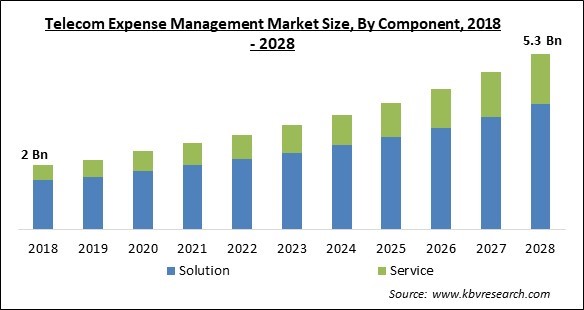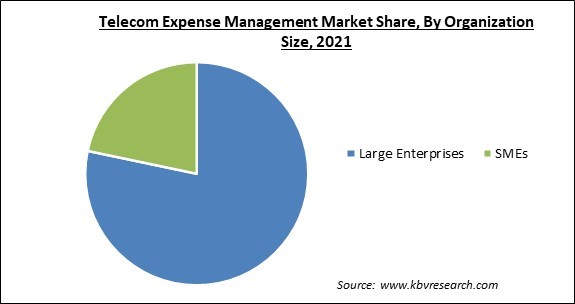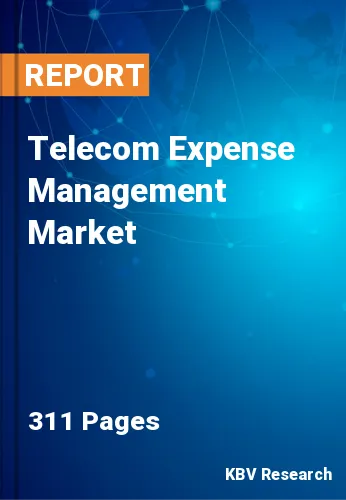The Global Telecom Expense Management Market size is expected to reach $5.3 billion by 2028, rising at a market growth of 10.8% CAGR during the forecast period.
Controlling and monitoring multiple wireless, voice, and data services to comprehend overall telecom expenditures is known as telecom expense management (TEM). This phrase is often used to describe commercial clients who make considerable telecom service commitments as part of their operational procedures.

Management of telecom expenses in the company may be challenging. That is partially attributable to the vast selection of telecom services provided by modern, forward-thinking telecom businesses. Businesses may utilize the software for managing telecom expenses, including visual dashboards indicating how much money is being spent with different telecom suppliers.
Similarly, companies may include several categories in their expenditure management business software to account for all their cloud software vendor expenses from suppliers like AWS. A required method of cost management, cost evaluation, and monitoring of the effects of a company's attempts to achieve a "desired state" in terms of total telecom services and functioning is telecom expense management.
The IT, procurement, and finance divisions of businesses may purchase, provide, support, and control the expenses of corporate telecoms, related IT services, and their inventory owing to telecom expense management services. These include cloud licensing, unified communications as a service [UCaaS] licenses, fixed and mobile telephony and data, and Internet of Things [IoT] connections. Business intelligence (BI) and reporting that may help C-level executives make strategic decisions are also included in TEM services. SaaS-based apps, platforms, managed services, and related professional services are the main areas of Gartner's TEM coverage.
The COVID-19 pandemic was advantageous for the industry for telecom expenditure control. The need for telecom expense management products and services is expected to increase in the post-COVID-19 future as businesses continue to depend on digital technologies. The demand for telecom expense management solutions and services is anticipated to grow as IoT technology is more implemented, smart devices proliferate, the work-from-home culture is accepted, and data volumes increase. Since businesses will experience negative consequences from the pandemic for some time, TEM providers must adapt their service portfolios. Enterprises may increase productivity, reduce the workload on internal teams, and free up more time to concentrate on innovation and generating revenue with the correct TEM strategies in place.
Costs associated with communications might be complex. Furthermore, there will be restrictions even for the most skilled financial departments. It is much more challenging to know that a company with worldwide expansion constantly obtains the most value from a telecom contract while operating in many nations, currencies, and tongues. Furthermore, bill quality will vary significantly depending on the area or telecom provider, and expenses may increase without the company owner being informed. Knowing precisely what a company pays for in each contract and achieving uniform insight into them is challenging. In the end, the market expansion would occur during the predicted period.
Since they are needed to communicate with customers and employees, telecommunication services represent a considerable portion of company expenses. Therefore, businesses are focusing on cost-saving strategies due to the growing cost of these services. Due to the ability to reduce their telecom costs, organizations have moved their attention to telecom exchange management solutions. These solutions provide methods for delivering the same services for less money, hence reducing telecom costs. Gaining control over telecom costs also frees up funds that firms utilize for other initiatives, enhancing the efficiency of their core operations. This supports the growth of the regional market.
Forecasting future expenditures, monitoring inventories on invoices, designating the proper cost center, and invoice processing are difficulties in managing telecommunications that impede market expansion. For producers, TEM software offers a variety of advantages, such as planning and expenditure visibility. Vendors, however, need to make it easier to use this software. Vendors can submit forged invoices and costs to the finance department undetected. Due to invoices, bills, and other expenses, the company may be paying more than is required. A great difficulty for consumers is ensuring the correctness of the taxes that are calculated in the costs. This would prevent the market from growing throughout the anticipated term.
Based on deployment type, the telecom expense management market is segmented into cloud and on-premise. The on-premises segment dominated the telecom expense management market in 2021. For businesses that handle sensitive information, on-premise is crucial since it is based on the actual physical setting. The most significant advantage of on-premise software is data protection since businesses have total control over their data and its security because the data is housed locally. In addition, organizations may also decide when to do software and hardware maintenance and updates.
By component, the telecom expense management market is fragmented into solutions and services. The service segment covered a considerable revenue share in the telecom expense management market in 2021. TEM services are being used by businesses because they give them the ability to preserve flexibility and concentrate their efforts on running their operations rather than handling complex IT infrastructure. Because TEM services have much lower initial costs than other options, they are particularly advantageous for small and medium-sized businesses, which helps the market flourish.
Based on organization size, the telecom expense management market is segmented into large enterprises and small and medium-sized enterprises (SMEs). The small and medium-sized enterprises segment generated the substantial revenue share in the telecom expense management market in 2021. Small and medium-sized businesses are increasing in both developed and emerging nations, which has led companies that are receptive to embracing the BYOD culture to lower the upfront IT expenditures that could impede their early development. Opportunities for telecom expense management in this market are anticipated as a result of these developments.
Based on the End-use, the telecom expense management market is divided into BFSI, Consumer Goods & retail, healthcare & Life Sciences, IT & telecom, manufacturing & automotive, and others. The BFSI segment registered the considerable revenue share in the telecom expense management market in 2021. The need for telecom expense management in the BFSI industry is rising as more individuals use mobile and online banking. Banking customers may monitor their telecom expenses for specific branches and compare them to one another. The insurance customers value the solution's ability to monitor the overall expenses attributed to remote personnel for crystal-clear insight into remote costs.

| Report Attribute | Details |
|---|---|
| Market size value in 2021 | USD 2.6 Billion |
| Market size forecast in 2028 | USD 5.3 Billion |
| Base Year | 2021 |
| Historical Period | 2018 to 2020 |
| Forecast Period | 2022 to 2028 |
| Revenue Growth Rate | CAGR of 10.8% from 2022 to 2028 |
| Number of Pages | 311 |
| Number of Tables | 550 |
| Report coverage | Market Trends, Revenue Estimation and Forecast, Segmentation Analysis, Regional and Country Breakdown, Companies Strategic Developments, Company Profiling |
| Segments covered | Component, Deployment Type, Organization Size, End-use, Region |
| Country scope | US, Canada, Mexico, Germany, UK, France, Russia, Spain, Italy, China, Japan, India, South Korea, Singapore, Malaysia, Brazil, Argentina, UAE, Saudi Arabia, South Africa, Nigeria |
| Growth Drivers |
|
| Restraints |
|
Based on region, the telecom expense management market is divided into North America, Europe, Asia Pacific, and LAMEA. By contributing the highest revenue share, the North American region dominated the telecom expense management market in 2021. The main driver of the market's growth in this area is the early adoption of telecom expense management products and services. One of the most significant marketplaces for the Telecom Expense Management Market is North America. The existence of established improves commercial opportunities for providers and substantial companies in the Telecom Expense Management sector in the North American area.
Free Valuable Insights: Global Telecom Expense Management Market size to reach USD 5.3 Billion by 2028
The market research report covers the analysis of key stake holders of the market. Key companies profiled in the report include Accenture PLC, NTT Data Corporation, CGI, Inc., Vodafone Group Plc, Calero-MDSL Ltd, Sakon, Inc., Avotus Corporation, Brightfin (Periscope Equity LLC), Tangoe, Inc., and Valicom (EXA Capital, LLC).
By End-use
By Organization Size
By Deployment type
By Component
By Geography
The global Telecom Expense Management Market size is expected to reach $5.3 billion by 2028.
An improved understanding of telecom bills is required are driving the market in coming years, however, Poor supplier performance and a low level of interoperability are preventing market growth restraints the growth of the market.
Accenture PLC, NTT Data Corporation, CGI, Inc., Vodafone Group Plc, Calero-MDSL Ltd, Sakon, Inc., Avotus Corporation, Brightfin (Periscope Equity LLC), Tangoe, Inc., and Valicom (EXA Capital, LLC).
The Large Enterprises segment acquired maximum revenue share in the Global Telecom Expense Management Market by Organization Size in 2021 thereby, achieving a market value of $4 billion by 2028.
The Solution segment is leading the Global Telecom Expense Management Market by Component in 2021 thereby, achieving a market value of $3.8 billion by 2028.
The North America market dominated the Global Telecom Expense Management Market by Region in 2021, and would continue to be a dominant market till 2028; thereby, achieving a market value of $1.8 billion by 2028.
Our team of dedicated experts can provide you with attractive expansion opportunities for your business.

